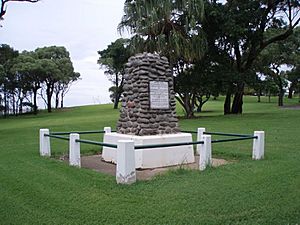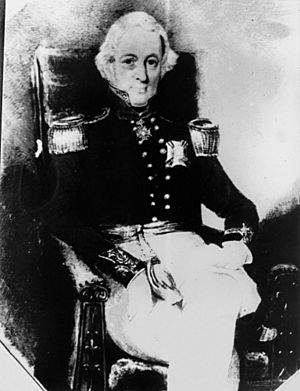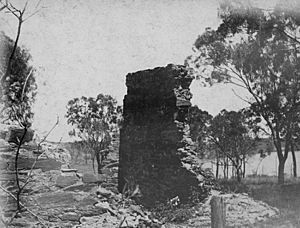Friend Park, Barney Point facts for kids
Quick facts for kids Friend Park, Barney Point |
|
|---|---|

Friend Park and Graves, 2009
|
|
| Location | Friend Street, Barney Point, Gladstone Region, Queensland, Australia |
| Design period | 1840s – 1860s (mid-19th century) |
| Built | 1854–1856 |
| Official name: Friend Park and Graves | |
| Type | state heritage (built, landscape) |
| Designated | 3 December 2003 |
| Reference no. | 601341 |
| Significant period | 1854-56, 1929- (historical, social) 1854-56, 1954, 1958 (fabric) |
| Significant components | plaque, trees/plantings, burial/grave, wall/s – retaining, park / green space, memorial – cairn, grave surrounds/railings, dais, playground, flagpole/flagstaff, sarcophagus |
| Lua error in Module:Location_map at line 420: attempt to index field 'wikibase' (a nil value). | |
Friend Park is a special park in Barney Point, Gladstone, Australia. It has a long history, going back to the 1850s. This park was once the home of the first government leader in the area. Today, it is a popular spot for picnics and playing. The park is listed on the Queensland Heritage Register because of its important past.
A Look Back at Friend Park
Friend Park is where the first government house and gardens were built in the Port Curtis area. This happened between 1854 and 1856. The house was for Captain Maurice Charles O'Connell. He was appointed as the Government Resident in 1854. This meant he was the main government official for the Port Curtis and Leichhardt areas.
Early Days of Gladstone
The town of Gladstone was started by the New South Wales Government in 1853-1854. Some historians think this was an effort to create a new capital city in the north. This was before Queensland became its own colony in 1859. In 1853, the Governor of New South Wales, Sir Charles Augustus Fitzroy, announced plans for a town at Port Curtis. A surveyor named Francis MacCabe was asked to map out the town of Gladstone.
Gladstone was named after William Ewart Gladstone. He was a British Colonial Secretary. In 1846, he tried to create a new colony in northern Australia. This colony was called North Australia. It included most of what is now Queensland and the Northern Territory.
The First Attempt to Settle
Gladstone wanted to send people who had finished their prison sentences to this new colony. This idea was not popular in New South Wales. In late 1846, a new Colonial Secretary, Earl Grey, stopped the plan. But before the news arrived, a settlement was attempted in 1847.
Colonel George Barney and his family arrived in Sydney in 1846. He explored the coast and chose Port Curtis for the settlement. He and 87 officials and settlers arrived at Port Curtis in January 1847. They faced a very wet season. Their ship got stuck, and they waited on Facing Island for seven weeks. They mostly ate dried meat and biscuits.
News then arrived that the colony would be closed. The settlement was stopped between April and July 1847. Colonel Barney explored the Gladstone area during this time. He thought Port Curtis had a great natural harbour. Barney Point is named after him.
A New Start for Gladstone
Six years later, in 1853, a second attempt to settle Port Curtis was successful. Francis MacCabe finished his map for the Town of Gladstone. He chose the area near Auckland Inlet for the main town. He also set aside land for government buildings and a large area for a Government House and gardens. This plan was approved, and the Town of Gladstone was officially declared in December 1853.
Captain O'Connell's Home
On January 1, 1854, Captain Maurice Charles O'Connell was appointed as the Government Resident. He was also the Police Magistrate and Commissioner for Crown Lands. The first land sales for Gladstone happened in Sydney in February 1854. When O'Connell arrived in March 1854, some buildings were already up.
O'Connell and his family lived in tents at Barney Point Beach at first. This was the area now known as Friend Park. They later moved onto a ship for a month. A temporary government residence was then built: a large tent with a timber floor. This tent was likely set up in what is now Friend Park.
In April 1854, Governor Fitzroy visited Gladstone. He officially made O'Connell the Government Resident. In 1954, for Gladstone's 100th birthday, the community re-enacted this event. It took place in Friend Park. A stone monument, called a cairn, was put in the park to remember this day.
Life at the Government Residence
By July 1854, O'Connell decided the promontory at Barney Point Beach was a better place for the government residence. He started laying out gardens and fences. A permanent stone house began construction in 1855 and was finished in late 1856.
In September 1854, a young man named Thomas Milles Stratford Riddell died in an accident. He was helping to carry water when he fell under a cart. He was buried in the government domain, which is now Friend Park. By the early 1900s, his grave had a stone sarcophagus. Another person, Lieutenant Le Strange, was also buried there. His grave is no longer visible.
In May 1854, Gladstone had 127 non-Indigenous residents. A visitor in 1855 said that most people lived at Barney Point. This was likely in or near the area that became Friend Park.
O'Connell was not very popular in Gladstone. He was known for being strict. In late 1855, his actions were investigated. As a result, Port Curtis was no longer a full government residency. O'Connell stayed in Gladstone as the Lands Commissioner. He moved into the stone house in late 1856.
O'Connell became Government Resident again in September 1858. This was because many people came to the area after gold was found at Canoona. But most gold seekers went to Rockhampton instead. By June 1859, Gladstone's population was 203, while Rockhampton's was 250.
In June 1859, Queensland became a separate colony. O'Connell's job as Port Curtis Resident was no longer needed. He moved to Brisbane and became the President of the Queensland Legislative Council. He tried to buy his old house and land at Barney Point, but the government said no.
Changes and Challenges
A map from 1860 shows the government residence in what is now Friend Park. It had a main house, outhouses, stables, and a formal garden. No graves were shown on this map. Another survey in 1862 also showed the stone house and other buildings.
In 1864, the land was bought by Alfred Henry Brown. He was a six-year-old boy, the son of Henry Hort Brown. It is not known if the Brown family ever lived in the old government residence.
By 1888, the former government residence was abandoned. A drawing from that year shows crumbling stone walls and no roof. Photos from 1905 and 1906 show only small parts of the walls left. The site was covered in grass and small trees.
The Park Becomes Public
In the 1920s, people in Gladstone wanted to protect this historic site. In 1927, the Gladstone Chamber of Commerce asked the Council to save the graves at Barney Point. After Theresa Brown, the owner, died in 1927, the land was bought by Henry Friend junior in 1929.
From Ruins to a Park
Henry Friend junior bought the property to give it to the Gladstone Town Council. He did this in November 1929. The land was meant to be kept forever for the people of Gladstone. To thank him for his generous gift, the site was named Friend Park.
In 1935, George Simmons, a garden expert, helped plan improvements for Friend Park. Trees were also given to Gladstone for the park.
Friend Park Today
In 1954, a big celebration for Gladstone's 100th birthday happened. A cairn was unveiled in Friend Park. It remembered Captain Maurice O'Connell becoming Government Resident in 1854.
In the mid-1950s, the Gladstone Junior Chamber of Commerce built a children's playground in Friend Park. They gave the completed playground to the Council in December 1958.
Friend Park is still one of Gladstone's main parks. It is a popular place for picnics. In the late 20th century, the Gladstone City Council removed the old stone foundations of the 1856 government residence.
On June 22, 2003, a memorial cairn for Francis MacCabe was unveiled in Friend Park.
What Friend Park Looks Like
Friend Park is about 1.72 hectares in size. It is on a low piece of land that sticks out into Port Curtis. This land is at the southern end of Barney Point Beach. From the park, you can see great views across Port Curtis. The edges of the park have a rocky shoreline. On the west, Sutton Street borders the park, and Friend Street is to the south.
The park slopes down to the water. Some parts are gentle, others are steeper. The slopes are rocky and have small trees and grasses. The shoreline is mostly made of mud from the Calliope River.
At the northern end of Friend Park, a low stone wall separates the park from the beach. The ground here is grassy and like steps. Stones are set into the ground to help people walk up to the park.
Park Features
The park has an open lawn with different kinds of trees. These include a tall Norfolk Island Pine, fig trees, palms, and eucalyptus trees. There are also several memorials, a wooden platform, and playground equipment for children.
Important Memorials
Near the highest point of the park is the 1954 cairn. This is a four-sided stone monument with a flat top. It sits on a concrete base. A marble plaque on the north side of the cairn says:
On this spot the first official residence in North Australia was erected, and Captain Maurice Charles O'Connell was installed first Government Resident, Police Magistrate and Commission of Crown Lands, on 17th April 1854 by Sir Charles Fitzroy Governor of New South Wales. Unveiled Centenary Celebrations 17th April 1954.
In the middle-north part of the park is a low wooden platform. It has railings on three sides and a ramp for easy access. Just west of this is the grave of Thomas Riddell. It has a stone sarcophagus with two messages carved into it. There is also an iron fence around the grave. The messages on the sarcophagus say:
Underneath this stone are deposited the remains of THOMAS MILLES STRATFORD RIDDELL eldest son of the Acting Colonial Secretary and Mrs Riddell. and He was born at Sydney on 22 January 1832 and died at Port Curtis on the 16 September 1854 aged 22 years.
Further west is a steel flagpole. It was put there when the children's play area was created in 1958. A metal plaque on the flagpole says: This play area was planned and equipped by the Gladstone Junior Chamber of Commerce and presented to the citizens of Gladstone on 6 December 1958.
Even though there are no old buildings left above ground, there might be old items buried underground. These could tell us more about the park's past.
Why Friend Park is Special
Friend Park and its graves were added to the Queensland Heritage Register on December 3, 2003. This means it is a very important historical site.
Protecting History
Friend Park is one of the most important historical places in the Gladstone area. It is linked to the start of Gladstone town in 1853-1854. It is also important for Queensland's history. It was the site of the first government residence for the Port Curtis area. This area was once thought to be a possible new colony separate from New South Wales.
Learning from the Past
Even though most of the old buildings are gone, the park is important. It has the potential to show us archaeological information. This means we might find buried structures or items. These finds could help us understand what life was like in a government area in the mid-1800s.
Beautiful Views
The park is also special because of its beautiful views. The view from the headland across Port Curtis is still much like it was in 1854. This is when Captain Maurice O'Connell decided to build the government residence here.
Important to the Community
The local community has always valued this site. It is important to them because of its connection to Gladstone's early history. This was shown when Henry Friend junior bought the land and gave it to the Council in 1929. It was also shown when the cairn was built in 1954 to celebrate Gladstone's 100th birthday. The Gladstone City Council also nominated the old graves to the Queensland Heritage Register.



